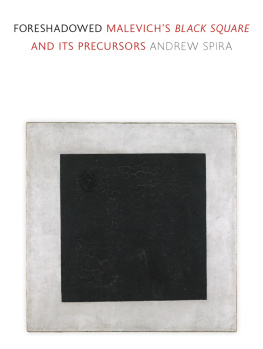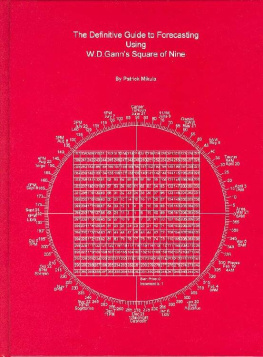FORESHADOWED

FORESHADOWED
MALEVICHS BLACK
SQUARE AND ITS
PRECURSORS
ANDREW SPIRA
REAKTION BOOKS
Published by Reaktion Books Ltd
Unit 32, Waterside
4448 Wharf Road
London N1 7UX, UK
www.reaktionbooks.co.uk
First published 2022
Copyright Andrew Spira 2022
All rights reserved
No part of this publication may be reproduced, stored in a retrieval system, or transmitted, in any form or by any means, electronic, mechanical, photocopying, recording or otherwise, without the prior permission of the publishers
Page references in the Photo Acknowledgements match the printed edition of this book.
Printed and bound in India by Replika Press Pvt. Ltd
A catalogue record for this book is available from the British Library
eISBN 9781789145366
CONTENTS
Preface
F or years I have tried to convince students that Malevichs Black Square (1915) is the most interesting and beautiful painting ever made. This is not necessarily on account of its visual appeal (though I have grown strangely fond of it) but because of its extraordinary significance. The story of its own emergence constitutes a summary of the development of modern art as a whole, and its influence underpins the evolution of twentieth- and twenty-first-century art. More than any other work, it asks: what is art? However, while the paintings genesis and influence can be shaped into a relatively coherent narrative, consistent with the history of the period as a whole, what I did not expect when I first began to research it was that it also appeared to send vibrations backwards into the past; it seemed to activate resonance in remote places mostly in books produced over the last five hundred years as if they were sympathetic strings. Given the universal association of the concept of art with naturalistic representation during this long period, it seemed extraordinary and incongruous that the form of a plain black rectangle should have somehow found its way into the otherwise carefully sequenced annals of history, ahead of time. Moreover, the connection was not merely visual; there also appeared to be deeper relationships that revealed genuinely new dimensions of meaning in Malevichs painting. How could Black Square seem to have cheated history and anticipate itself? This book addresses this curious phenomenon.

1 Kasimir Malevich, Black Square , 1915, oil on canvas.
Foreshadowed:
Malevichs Black Square
and Its Precursors
K asimir Malevichs Black Square is one of the most challenging and perplexing paintings ever produced. For some people, it is quite literally iconic (since it was hung in the position of a sacred icon when it was first exhibited in 1915; ), while for others it epitomizes the absurdity of modern art: I could have done that! Either way, whether people felt exhilarated or insulted by the painting when it first appeared, they had never seen anything like it before. In fact, it was so audacious that the painting of monochrome pictures has continued to serve as an avant-garde rite of passage ever since. But this book is not about Black Squares legacy. On the contrary, readers may be surprised to discover that, although the painting was shockingly innovative in its time not even resembling other works in the milieu from which it emerged it does have precedents. Indeed, for more than five hundred years, a number of painters, writers, philosophers and scientists each seeking an absolute in their own very distinct way have alighted on the form of the black square or rectangle as a means of expression, as if for the first time. While their journeys there have been diverse metaphysical, valedictory, comic, symbolic, psychological, optical the end results have one feature in common: each of them involved the process of an individual painstakingly blotting out a rectilinear space with the darkest possible pigment, to the point of exclusion. Some of the results of this process endpoints beyond which it was impossible for their authors to go had as much pathos in their own contexts as Malevichs had in his; and many of them have an astonishing graphic power and freshness, even by todays standards.
Foreshadowed explores the resonances between Malevichs Black Square and its precursors. Despite the lack of manifest connection between many of the examples cited (most of which are unknown to art lovers, academics and students), a genealogical connection links them together in an intriguing, and sometimes quirky, sequence of modulations. This book explores how each of these black rectangles both foreshadows Malevichs work and, paradoxically, throws light on it, eliciting significances from it that are often overlooked but which are as pertinent today as they ever have been.
When Kasimir Malevich painted his Black Square in 1915 (), he thought he was consummating the history of art. He maintained that after centuries of human struggle towards clarity and depth, glimpsed through a veil of images, the medium of art had become both complete and defunct; it was no longer needed as an intermediary between the conscious individual and the essence, or truth, of life. With his help, that essence had now become self-evident, revealed immediately through the experience of life itself. The crutch that was art had served its purpose and could now be thrown away; so too could the bourgeois sense of a personal self to which the concept of art corresponded. A higher, selfless world was now revealed.
Though a world without art may seem drastic to us, this was not bad news for Malevich, any more than the demise of the caterpillar is bad news for the butterfly. On the contrary, it was a liberation, a revelation that the meaning of existence whatever that might be is not concealed at the end of the labyrinthine process of life that human beings must negotiate or endure, to be revealed at some time in the future, but that it is inherent in present experience and existence, and is directly accessible now.
While Malevich advocated the immediacy and presence of the essence of life, he also maintained that to perpetuate the tradition of art constituted a perpetuation of the attachment to a cultural convention which now served to keep attention away from that essence, in order to avoid having to sacrifice the sense of personal self with which the concept of art was coterminous. Art had become a kind of cultural addiction, obstructing, rather than facilitating, clarity. Black Square, therefore, was not just the revelation of a truth. It was also a sign, or gesture, of release; it was a renunciation, by an artist on behalf of the world, of the illusions and relationships on which the entire concept of art depends. First, it renounced all iconographic references (subject matter). Having no subject matter whatsoever, it is non-objective: that is to say, there are no objects to which it refers, however abstractly. There is not even an impression of visual depth, which, on a two-dimensional surface, is an illusion and therefore a kind of basic subject matter. Second, it renounced all formal narratives any purely visual relationships that may exist in a work of art, whether that work is representational or not. As a result, it brought the tradition of art history to an end. Indeed, the contemporary critic Nikolai Punin wittily dubbed














